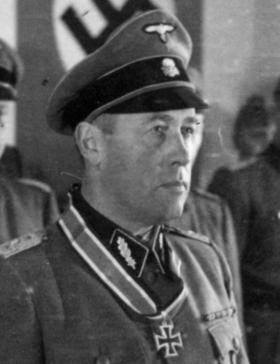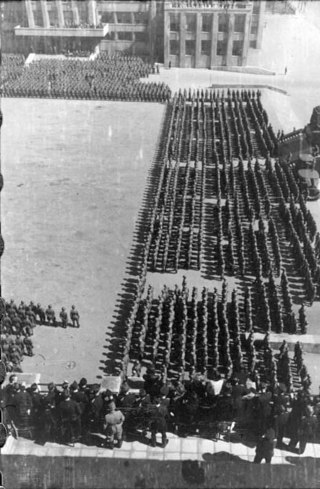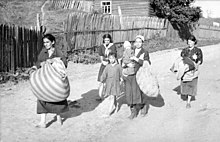
Arthur Nebe was a German SS functionary who held key positions in the security and police apparatus of Nazi Germany and was, from 1941, a major perpetrator of the Holocaust.

The Ordnungspolizei, abbreviated Orpo, meaning "Order Police", were the uniformed police force in Nazi Germany from 1936 to 1945. The Orpo organisation was absorbed into the Nazi monopoly on power after regional police jurisdiction was removed in favour of the central Nazi government. The Orpo was controlled nominally by the Interior Ministry, but its executive functions rested with the leadership of the SS until the end of World War II. Owing to their green uniforms, Orpo were also referred to as Grüne Polizei. The force was first established as a centralised organisation uniting the municipal, city, and rural uniformed police that had been organised on a state-by-state basis.

Kurt Max Franz Daluege was a German SS and police official who served as chief of Ordnungspolizei of Nazi Germany from 1936 to 1943, as well as the Deputy/Acting Protector of Bohemia and Moravia from 1942 to 1943.
There were two main Police forces of Nazi Germany under the Reichsführer-SS, Heinrich Himmler from 1936:

Gustav Lombard was a high-ranking member in the SS during World War II. During the war, Lombard commanded 8th SS Cavalry Division Florian Geyer and the 31st SS Volunteer Grenadier Division. He was a recipient of the Knight's Cross of the Iron Cross of Nazi Germany for so-called "anti-partisan" operations around Kovel which involved killing of civilians and burning down villages.
Reserve Police Battalion 33, "Ostland", was a militarised unit of the German Ordnungspolizei in World War II. For the first three months between August and October 1941 – according to Latvian Museum of Occupation – its official name was Police Reserve Battalion "Ostland" and, from October 1941, the 33rd Reserve Police Battalion. The 1st Company of Battalion 33 was known as Ostlandkompanie. It was composed largely of Estonian Volksdeutsche.

Max von Schenckendorff was a general in the Wehrmacht of Nazi Germany during World War II. He was the commander of Army Group Rear Area behind Army Group Centre from March 1941 until his death. He is best known for organising the Mogilev conference, in which Wehrmacht and SS officers discussed "bandit fighting" tactics, meaning the mass murder of Jews and other real or perceived enemies. The conference resulted in an intensification of the genocide that was already taking place in Army Group Centre Rear Area.
The Mogilev Conference was a September 1941 Wehrmacht training event aimed at improving security in the rear of Army Group Centre during the German invasion of the Soviet Union. The event was organised by General Max von Schenckendorff, commander of Army Group Centre Rear Area, in cooperation with the officials of the security and intelligence services of Nazi Germany—SS and the Sicherheitsdienst —operating in the same area. Ostensibly an "anti-partisan" training conference, the event marked an escalation of violence against Jews and other civilians in the areas under Schenckendorff's command.

The Police Regiment Centre was a formation of the Order Police during the Nazi era. During Operation Barbarossa, it was subordinated to the Schutzstaffel (SS) and deployed in German-occupied areas, specifically the Army Group Centre Rear Area, of the Soviet Union. In mid-1942, its three constituent battalions were reassigned and the unit was re-designated as the 13th Police Regiment.
The Police Regiment South was a formation of the German Order Police, the German national uniformed police force, during the Nazi era. During Operation Barbarossa, it was subordinated to the Schutzstaffel (SS) and deployed in German-occupied territories, specifically the Army Group South Rear Area. In July 1942, its three constituent battalions were redesignated as the 10th Police Regiment.
The Police Battalion 316 was a formation of the Order Police during the Nazi era. During Operation Barbarossa, it was subordinated to the SS and deployed in German-occupied areas, specifically the Army Group Centre Rear Area, of the Soviet Union, as part of Police Regiment Centre. Alongside detachments from the Einsatzgruppen and the SS Cavalry Brigade, it perpetrated mass murder in the Holocaust and was responsible for large-scale crimes against humanity targeting civilian populations under the guise of "anti-partisan" warfare. In mid-1942, the battalion was reassigned to the 4th Police Regiment and operated in Slovenia.
The Police Battalion 307 was a formation of the Order Police during the Nazi era. During Operation Barbarossa, it was subordinated to the SS and deployed in German-occupied areas, specifically the Army Group Centre Rear Area, of the Soviet Union, as part of Police Regiment Centre. Alongside detachments from the Einsatzgruppen, it perpetrated mass murder in the Holocaust and was responsible for large-scale crimes against humanity targeting civilian populations. In mid-1942, the battalion was reassigned to the 23rd Police Regiment and operated in Belarus.
The Police Battalion 314 was a formation of the German Order Police during the Nazi era. During Operation Barbarossa, it was subordinated to the SS and deployed in German-occupied areas, specifically the Army Group Centre Rear Area, of the Soviet Union, as part of Police Regiment South. Alongside detachments from the Einsatzgruppen and the 1st SS Infantry Brigade, it perpetrated mass murder in the Holocaust and was responsible for large-scale crimes against humanity targeting civilian populations.
The Police Battalion 303 was a formation of the German Order Police during the Nazi era. During Operation Barbarossa, it was subordinated to the SS and deployed in German-occupied areas, specifically the Army Group Centre Rear Area, of the Soviet Union, as part of Police Regiment South. Alongside detachments from the Einsatzgruppen of the SD and the 1st SS Infantry Brigade of the Waffen-SS, it perpetrated mass murder in the Holocaust and was responsible for large-scale crimes against humanity targeting civilian populations.
The Police Battalion 45 was a formation of the German Order Police during the Nazi era. During Operation Barbarossa, it was subordinated to the SS and deployed in German-occupied areas, specifically the Army Group Centre Rear Area, of the Soviet Union, as part of Police Regiment South. Alongside detachments from the Einsatzgruppen of the SD and the 1st SS Infantry Brigade of the Waffen-SS, it perpetrated mass murder in the Holocaust and was responsible for large-scale crimes against humanity targeting civilian populations.
The Police Battalion 320 was a formation of the German Order Police during the Nazi era. During Operation Barbarossa, it was subordinated to the SS and deployed in German-occupied areas, specifically the Army Group South Rear Area, of the Soviet Union, as part of Police Regiment Special Purpose. Alongside detachments from the Einsatzgruppen of the SD, it perpetrated mass murder in the Holocaust and was responsible for large-scale crimes against humanity targeting civilian populations.
The Police Battalion 309 was a formation of the Order Police during the Nazi era. During Operation Barbarossa, it was subordinated to the German Army's 221st Security Division and deployed in German-occupied areas, specifically the Army Group Centre Rear Area, of the Soviet Union, as part of Wehrmacht's security forces. Alongside detachments from the Einsatzgruppen and the SS Cavalry Brigade, it perpetrated mass murders and was responsible for large-scale crimes against humanity targeting civilian populations.
The Police Battalion 306 was a formation of the Order Police during the Nazi era. During the Soviet-German war of 1941–45, it was deployed in German-occupied areas of the Soviet Union, as part of Nazi Germany's security forces tasked with "bandit-fighting". Alongside other SS and police units, it participated in the Holocaust and was responsible for large-scale crimes against humanity targeting civilian populations.

The Order Police battalions were militarised formations of the Nazi German Ordnungspolizei. During World War II, they were subordinated to the SS and deployed in German-occupied areas, specifically the Army Group Rear Areas and territories under German civilian administration. Alongside detachments from the Einsatzgruppen and the Waffen-SS, these units perpetrated mass murder of the Jewish population and were responsible for large-scale crimes against humanity targeting civilian populations.

1941 Białystok massacres refers to the series of pogroms and mass executions committed by the Ordnungspolizei and SS against the Jewish population of Białystok in occupied Poland. These atrocities were committed at the turn of June and July 1941, following the German invasion of the USSR.








